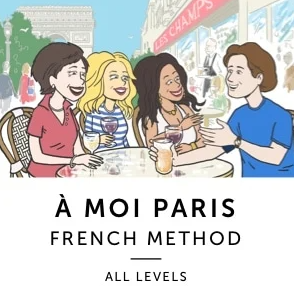Duolingo French review
I have been teaching French since 2014 and speak almost 7+ langauges. Over the years the topic of Duolingo French has come up in my lessons and it’s been a point of contention. I’ve tried Duolingo for other langauges and have concluded myself that it’s really just a glorified video game which offers a false promise of speaking fluently. Today’s post examines the pros and cons of Duolingo French.

In a sea of online language learning platforms, Duolingo French stands out. The bite-sized language learning model fits neatly into a fast-paced world. And with 100+ million downloads, the developers have seemingly found the magic formula for sustaining interest in language learning.
Duolingo markets itself as the “free, fun, and effective way to learn a language.” And it’s hard to disagree with the first two claims.
But what about that claim to effectiveness: does their cheerful, gamified approach have limitations?
We share what we learned about using this insanely popular app in a Duolingo review that pulls no punches.
Is Duolingo good for learning French?
Before we look into the mechanics of Duolingo French, let’s get the most crucial question cleared up.
Can Duolingo help you learn French?
The answer is yes, but mostly in the early stages.
Duolingo French can be a game-changer if you’ve just started your learning journey. The bright, intuitive interface lures beginners in and quickly expands their vocabulary.
If it’s your first acquaintance with masculine vs. feminine words or mystifying irregular French verbs, their uncomplicated format is a compelling springboard to more advanced learning.
But when you need to jump to the next level, Duolingo is limited. Duolingo French is built on repetition, which reinforces elementary lessons but will frustrate advanced learners.
While your vocabulary may expand, you won’t learn the rules underpinning the French language.
The rigid approach to learning can’t adapt to your individual needs, and no app can replace live conversation and hearing speakers in natural settings.
At some point, you will likely reach a ceiling and look for more useful tools, like À Moi Paris (read our review).
Can Duolingo French help me speak fluently?
Duolingo doesn’t promise fluency. True fluency can take years of dedicated learning. Ideally with ample opportunity to put that learning into practice.
Duolingo claims users can reach B2 in the Common European Framework of Reference for Languages. B2 is upper-intermediate level or basic fluency. It is considered sufficient to live and work in a country.
They back their bold claim up with a handful of commissioned studies.
According to one study, Duolingo learners (level 7) demonstrate the same skills as university students who’ve received five semesters of language teaching. Probably raising a few bushy eyebrows in academic circles.
It’s a pretty startling claim. But also an admission that Duolingo will not make you completely fluent in French.
Duolingo French excels at introducing structured language learning in a highly flexible format that spurs you to more learning. If you’re a hesitant learner, too busy, or relish the gaming format, Duolingo can help move you forward.
Duolingo also ramps the difficulty up as you progress, testing language skills beyond beginner level. But if fluency is the goal, you’ll probably need more expansive teaching at some point.
How much does Duolingo cost?
As we mentioned at the top of this Duolingo review, the app and browser versions are free.
Just sign-up by email, and you’re ready to go.
Of course, few apps are free. Duolingo is supported by ads and in-app purchases, and two subscription tiers.
Free Duolingo
If you use the app from Android or iOS on the free tier, you’ll have to put up with some non-intrusive ads that can usually be skipped after five seconds.
You can also buy gems and lingots (gamification permeates the app) for in-app purchases. They can also be earned (slowly) with achievements.
Gems can be used for purchases like freezing a streak if you need a day off or buying hearts, amongst myriad other optional benefits.
Duolingo uses hearts to limit extended free usage, much like video games.
Hearts are awarded free, and you gain an extra one every 5 hours, to a maximum of 5. But you lose one every time you make an error.
Duolingo claims losing hearts discourages users from speeding ahead and harming learning. But they also award unlimited hearts on their paid subscription plans, and you can use gems to buy more. So, you may want to take that with a pinch of salt.
You can also play to your heart’s content on the browser version, where this system is dropped.
Overall, the free tier is good. You can learn without spending a cent as long as you can live with ads and without fringe benefits.
Premium Duolingo subscriptions
Duolingo keeps prices well hidden until you try to order. Here are the prices we found when requesting to upgrade:
- Super subscription: Cost – $12.99 (monthly) / $155 (annually)
- Super Family subscription for 6 accounts: $230 (annually)
Other Duolingo reviews talk of $6.99 monthly fees. That price is based on the annual subscription.
When we wrote this Duolingo review, you could bag a 60% discount with an annual subscription. This gets the price closer to the rates mentioned everywhere but on the Duolingo website.
The only surefire way to know the price you’ll be charged is by checking your account. You can ease in with a 14 days free trial if you’re hesitant to fork out for comparatively high fees.
What are the benefits of a Duolingo Super subscription?
The premium subscriptions come with four perks:
No more ads
The first and most welcome perk is bidding au revoir to those pesky ads.
Unlimited hearts
Unlimited hearts is a notable advantage.
It’s not a license to guess, but at least you no longer worry about wrong answers hindering daily progress.
Personalized learning
Personalized learning is an intriguing feature and worth sampling with the free trial.
The app automatically generates an additional linked learning module if you make an error. It’s an afterschool lesson that teaches through reinforcement.
However, it’s not essential. You’ll still learn about the mistake for free and likely face a similar question soon after. Especially as you cannot progress until you master the skill.
Duolingo ‘test-outs’
Duolingo users unlock new ‘skills’ and learning paths by passing tests. The final perk of a Super subscription is the option to jump ahead by taking tests early.
Although unnecessary, it is useful when Duolingo limits advancement by focusing on a language competency you’ve already nailed.
What levels does Duolingo teach?
Duolingo French, despite their claims, is best for beginners. It will help users with A1/A2 competency if used as part of a broader learning program.
B1/B2 level learners may find Duolingo helpful to test themselves and keep their language circuits firing at opportune moments.
C1/C2 speakers will struggle to find anything interesting. Unless they enjoy collecting virtual trophies and spotting the occasional mistake.
How does Duolingo work?
Writing a Duolingo review in 2023 means writing about a very different app to the 2022 iteration.
Learning trees that branched in different directions have been condensed into one linear pathway.
As a wave of one-star reviews attests, the results have not gone down well with existing users.
For many, the new-look Duolingo has amped up the gaming aspect at the expense of more intense learning. But despite some sizeable changes, the underlying mechanics are unchanged.
At its heart, Duolingo is a game. Users are rewarded for improved performance with trophies, streaks, achievements, gems, lingots, and more.
Users pick their goals, and Duolingo eggs you on like a relentlessly optimistic teacher with a tote bag full of gold stars.
It’s compelling, with a friendly interface and a healthy dose of vibrant animations to cheer you on and encourage you to meet your daily goals.
There’s a community of fellow learners to connect with, and ultra-competitive users can even compete in leaderboards.
There’s never a downbeat moment. Mistakes are embraced as part of the learning curve. While completing a daily goal will earn rewards, so there’s something for even the most casual users.
What are Duolingo rewards?
To earn rewards, users follow a learning path.
It starts with an initial set of exercises to determine your current level. After that, you follow a path paved with learning exercises. Finish an exercise, collect any loot and accolades, and the next challenge awaits.
The primary objective is to earn skills in a specific topic: family, work, travel, etc.
Complete five skills to earn a crown and new skills to work on. Experience points are also picked up as you progress.
It sounds convoluted. But think of it as an overall objective broken into smaller segments. That means you can move forward with just 5-20 minutes of practice per day.
After a few hours, the side challenges and awards make sense. But you can also ignore them. Duolingo will automatically lead you down the learning path, progressing to higher-level skills as you accumulate rosettes and other awards.
What kind of language learning exercises are on Duolingo?
This is where Duolingo shines. Exercises are an interactive mix of listening, reading, writing, and AI speaking challenges.
They start gently and escalate in difficulty as you progress up the learning ladder.
Exercises are generally multiple-choice, like:
- Match an image to a word (flashcards)
- Match words to their English translation or in the target language
- Restructure a sentence in the correct order
- Select missing words
- Listen to audio and choose the correct phrase or combination.
There are speaking exercises where you use your microphone to repeat or create sentences.
The speaking exercises are surprisingly satisfying. And audio is sometimes accompanied by text, which can help improve listening skills.
Audio exercises can be skipped temporarily if you’re stealthily working on your streak at the office.
Although inventive, exercises can quickly become repetitive, and multiple-choice questions can be too easy.
But overall, Duolingo exercises are immersive, varied, and user-friendly. They’re a solid introduction to French if you seek the confidence to order a bowl of bouillabaisse or navigate Paris without a phrasebook.

Can Duolingo get you to B2 level?
According to Duolingo, B2 competency in the CEFR model is the ultimate goal.
They have published studies that paint a positive picture. Yet B2 is an optimistic target.
B2 Language speakers can do the following:
- Communicate freely, clearly, and precisely
- Speak spontaneously in conversation
- Be understood in most situations
- Read and write to a level that is understood.
The standout problem with Duolingo is you cannot interact with other speakers. There is a sizeable leap from answering multiple-choice quizzes to finding the right words in real life.
Duolingo French gives you answers to questions, but you don’t gain a detailed understanding of your errors. You miss the helpful context a tutor can add.
While elementary language learners can progress with Duolingo French, the limited framework is ultimately less effective than other learning methods if you want to reach B2 fluency.
How long does it take to complete Duolingo French?
In theory, there is no end to Duolingo. The aim is to keep stretching those streaks with a daily goal. And there is no limit to how long a streak lasts.
The Duolingo Reddit forum is filled with posts of multi-year streaks. One Redditor completed a 3,000-day streak, which will take some beating.
Does Duolingo have a podcast?
Duolingo posts weekly podcasts in four supported languages. French for English speakers, for example.
The podcast can be heard on their website and via several platforms, including Spotify.
Duolingo French podcasts last 15-20 minutes and are styled as listening exercises, usually with a culturally insightful theme.
Even if you’re not a Duolingo user, their podcasts can be valuable to language learners who want to hear the spoken word in vaguely realistic situations.
Our Duolingo French review in a nutshell
Duolingo French is undoubtedly smart. Its developers deserve credit for getting people excited about language learning with a flexible tool that delivers a healthy dopamine hit of teaching with rewards.
As our Duolingo review reveals, it is a viable tool for beginners and moderately helpful for intermediate learners. If fluency is your goal, you’ll need more than Duolingo.
But Duolingo French is a lot of fun. With a free subscription, you can have no complaints. Until the next update, at least!


